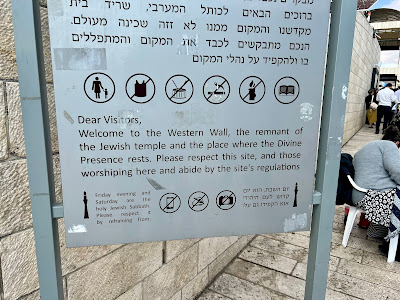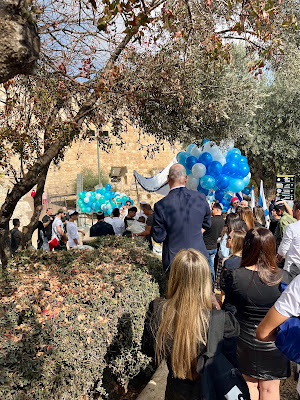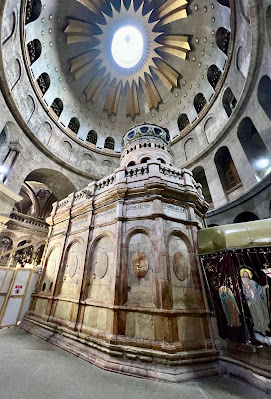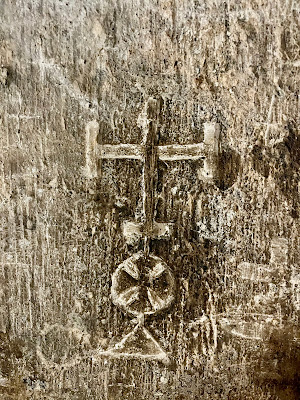Our next day in Jerusalem, we visited the Western Wall, also known as the Wailing Wall. It is considered the most religious site in the world for Jewish people. Located in the old city, it's the last remaining outer wall of the ancient Jewish temple. Interesting fact - the wall is split into two sections, with separate areas for males and females to gather.
Attendance numbers show that over 12 million people of all faiths journey to the wall every year to visit and recite prayers. Traditionally, these prayers are either spoken or written down and placed in the cracks of the wall. We saw many, and added our own personal prayers on little rolled up pieces of paper. I also put both of my hands on the wall and prayed for the salvation of the US and our world.
We were told by our guide Noam that one of the best experiences a Jewish family can undertake is to have their child's Bar or Bat Mitzvah at the Western Wall. Sure enough, we witnessed a couple of these lively celebrations taking place.
En route to the Church of the Holy Sepulchre, we walked past some ancient Roman ruins that were visually interesting.
Our path also led us by a local mosque. I circled the speakers near the top of the minaret in the pic below. Five times a day, the Islamic muezzin recites a droning prayer in Arabic, the language of the Quran, that's broadcast from the minaret's speakers at dawn, noon, midafternoon, sunset and nightfall - all based on the sun's position in the sky.
The Church of the Holy Sepulchre is celebrated as the place of the crucifixion, burial and resurrection of Jesus Christ, and has long been a major pilgrimage center for Christians all around the world. It's the location of the last four stations of the cross, one right outside the church, and the last three inside. According to the New Testament, Jesus was crucified at Golgotha, “the place of the skull” (Matt. 27:33–35; Mark 15:22–25; John 19:17–24). This has been identified as an area of abandoned stone quarries just outside the city wall of the time. About 10 years after the crucifixion, a third wall was built that enclosed the area of the execution and burial within the city, and this accounts for the Holy Sepulchre’s location inside the Old City of Jerusalem today.
The first Church of the Holy Sepulchre was approached by a flight of steps from the main street of Jerusalem. Pilgrims then went through a narthex (entry porch) into the basilica and then to an open area called the holy garden. This contained the rock of Golgotha, finally reaching the Holy Sepulchre itself. The whole complex was richly decorated, then and now. Damaged by fires and destroyed by Arabs/Muslims over the centuries, Christians were often denied access to the church. Rebuilt in the 12th century by the First Crusade, it's essentially the same church seen today with its many chapels.

There were lots of lamps with candles and incense suspended in various places around the site as seen in my pictures.
The picture below shows the stone of unction, or stone of anointing. This is celebrated as the place where Jesus' body was laid down after being removed from the cross and prepared for burial. He was anointed with herbs and wrapped in strips of linen as the Jews customarily prepared their dead for burial at this time. I witnessed many people kneeling to touch and kiss the stone.
Located behind this is an intriguing and equally ancient space overlooked by most pilgrims. At first glance it appears to be a run down back room known as the Chapel of St Nicodemus. In the far wall of this incredibly plain little chapel is the opening (seen in my first pic above) to a rock hewn, two body tomb, which our guide told us was an outstanding example of an upscale Jewish burial 2000 years ago.
This tiny tomb I bent to step inside was supposedly the tomb of Nicodemus, a Jewish man mentioned in the gospel of John. Nicodemus helped Joseph of Arimathea take Jesus' body away after the crucifixion and prepare him for burial in John 19. However, the Pharisee Nicodemus is undoubtedly better remembered in John 3:1-15 when he comes to acknowledge Jesus was sent from God. Jesus went on to explain to Nicodemus how we must be born again to see the kingdom of God. This conversation leads to one of the most well-known verses in the Bible at John 3:16: For God so loved the world that He gave His one and only Son, that whoever believes in Him shall not perish but have eternal life.
I learned on our tour that Roman Catholics, Eastern Orthodox,
and Armenian Apostolics all have rightful access to the interior of Jesus' tomb, and all three hold Holy Mass there daily. A fact I didn't know is that the Armenians adopted Christianity as their national religion in 301 AD, more than ten years before Constantine the Great adopted Christianity in the Roman Empire. That explains their presence in Jerusalem and the fact that they have their own quarter in the old city.


































No comments:
Post a Comment